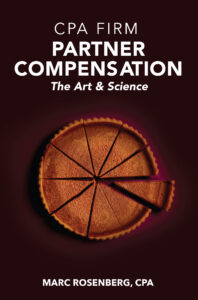Operating-Model Flaws Guaranteed to Complicate Partner Compensation: Flaw 1 of 3
Partners at multi-partner CPA firms earn $300-600K a year, more than 99% of all people on earth. How can I have the audacity to suggest that the traditional CPA firm operating model is deeply flawed when partners live so high off the hog? Easy. Money is not the sole measure of excellence.
 Many CPA firms earn this fantastic income in spite of themselves. Other measures of success are succession planning (at which CPA firms are awful), the development of a great staff, clients’ needs being met with diverse services, revenue growth, client retention and perhaps the most important – job satisfaction for the partners.
Many CPA firms earn this fantastic income in spite of themselves. Other measures of success are succession planning (at which CPA firms are awful), the development of a great staff, clients’ needs being met with diverse services, revenue growth, client retention and perhaps the most important – job satisfaction for the partners.
There are two overarching issues with the CPA firm operating model. First, firms are run like a partnership instead of a corporation (refers to the style of management, not their legal entity), which often results in a focus on individual efforts instead of teamwork and emphasizes short-term over long-term profitability. Second, partners usually wear too many hats – firm management, business development, managing a large client base, doing billable work – usually at the expense of firm management and developing staff.
The consequences of this model reverberate throughout the operation of CPA practices and has enabled us to make a nice living consulting to firms as they address the changes necessary to overcome them. This three-part blog series focuses on how specific operating-model flaws impact partner compensation systems.
Operating Model Flaw #1: Measuring partner performance based on individual production to the near-exclusion of other critical factors. Most firms under $10-15M disproportionately focus their measurement of partner performance on traditional production or FMG – (F)inding (bringing in business), (M)inding (managing a client base) and (G)rinding (performing billable work). With this heavy focus on partner production, it’s almost impossible for partners to earn a grade of “A” in other areas such as firm management, developing and nurturing staff, delivering world-class service and helping the firm achieve its strategic plan.
How flaw #1 impacts partner compensation. There’s a saying in management circles: “You get what you reward.” Of the critical performance factors above, partner compensation dollars often skewed excessively toward FMG, with few incentives for excelling in the other areas, even though we all know they are also important. That’s a shame because both the short and long-term excellence of a CPA firm are heavily dependent on these other factors. As a result, many firms underachieve and sacrifice long-term success for short-term gain. Perhaps the most serious ramification of this misguided focus on production is the failure of 80% of first-generation firms to make it to the second.
Bottom Line: your partner comp system should adopt critical performance criteria other than FMG. These criteria should have significant enough weight in the system to drive the intangible behaviors you need for your firm to succeed.
CPA Partner Compensation: The Art and the Science explains ►Partner comp 101 ► the 12 systems used by all firms ►how to design your firm’s system ►open vs. closed systems ►the role of “book of business” ►differences between large and small firms’ systems ► the MP’s compensation ► trends and controversies and ►overall best practices.
In our next post on this topic, we’ll discuss CPA Firm Operating Model Flaw #2 related to complacency.
1 Comments

CPA Firm Partner Compensation: The Art and Science
No one partner compensation system applies to all firms. Both subjective judgment and quantifiable methods and tactics must be employed to result in an outcome that satisfies the partners and is perceived as fair. Tailor your partner comp system specifically for your firm: here's how.
Learn More
We have a corporate model and average income per partner in excess of that stated. Please feel encouraged to see the Harvard Business School Case on Perelson Weiner LLP, if you like.